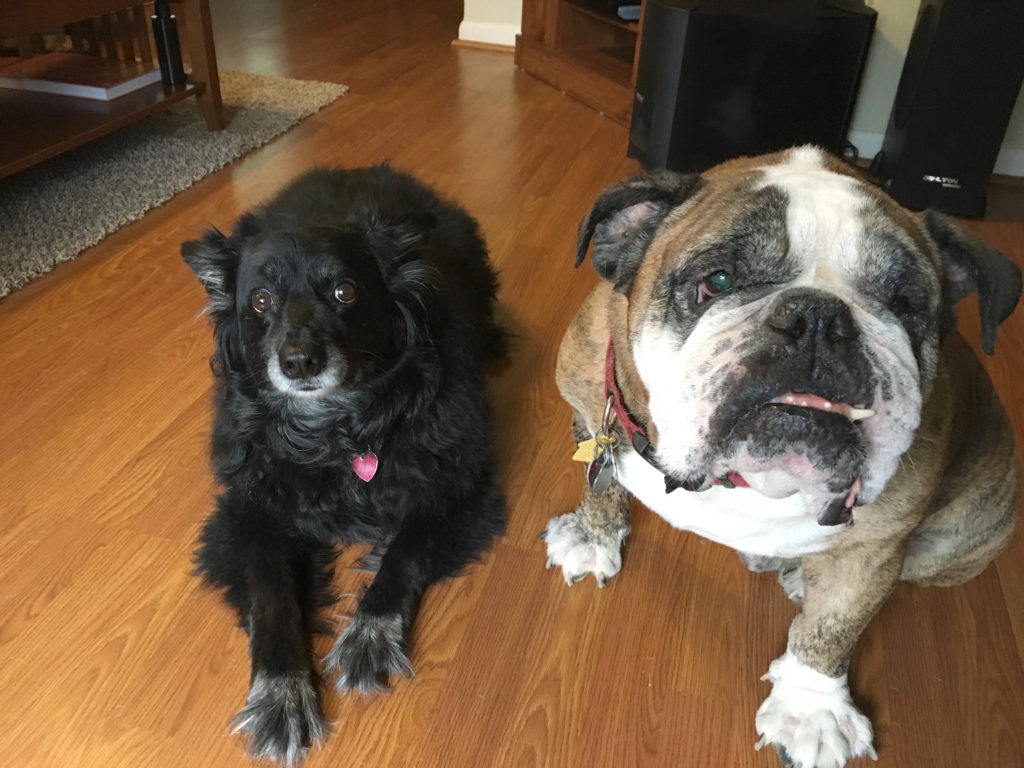Some Positive Dog Training Helps a Pair of Dogs Learn to Listen Better
By: David Codr
Published Date: October 12, 2016
Dizzy (left) is a seven-year-old Australian Shepherd who is very attached to one member of the family, not listening to their spouse. She lives in Omaha with Butch, a five-year-old English Bulldog who doesn’t listen well or come when called. Their guardian booked a dog obedience training session with us to get the dogs to listen better.
The dogs were curious and confident while interacting with me when I arrived for the session.
I sat down with the dogs guardians to get a little bit more information about them and how I could help. In the course of that discussion I learned that Dizzy was primarily the wife’s dog and Butch fell into the husband’s camp.
When we have multiple dogs that only identify with one particular owner in a home, this can lead to all sorts of behavioral issues. I strongly recommended that the guardians stop referring to each the dog as theirs and the other dog as their partner’s – and instead think about both dogs belong to both of them.
I also recommended that the guardians go to YouTube and select six new tricks or commands to teach the dogs. Each week a different guardian would be the dog trainer. I suggested that they teach the dogs the trick separately and then after doing so, teach the other guardian the command. For the rest of the week, they should practice this command with both dogs until they have it down cold.
I really like the dynamic that develops when we are teaching our dogs new skills. By having the guardians alternate and take turns instructing both dogs this way, this will help them start to see the humans as authority figures and identify as a pack of dogs as opposed to individuals.
I also recommended that the guardians start to enforce some rules and boundaries to further help the dogs identify as being in a follower position. This is an important perception for dogs to have if we want them to listen to us and follow our instructions.
Because the dog’s did not respect their authority, the guardians had been rearranging their lives to accommodate the dog’s indiscretions rather than training the dogs to follow rules and respect boundaries.
An example of this was the trash can. Instead of teaching the dogs to stay out of the trash, the guardians had either eliminated the trash cans themselves or incorporated trash cans with lids to prevent the dogs from getting into them.
I always want the dog to learn how to live with the humans and follow our rules rather than the humans rearranging their life to accommodate unruly behavior.
I spent a couple of minutes explaining how the guardians can teach the dogs to stay out of the trash by communicating that the can is to be left alone in a way they understand and respect.
The guardians will be able to incorporate the same technique with any object or area that they want the dogs to avoid; shoes, baby toys, etc.
Another great way to help dogs see humans as being the authority figures is to add a little bit of structure to petting or providing them with affection. I like to call this Petting with the purpose.
As we were wrapping up the Petting with a purpose discussion, I noticed the dogs were taking turns shoving their way past their guardians who were sitting on the couch. I used this as an opportunity to teach the humans how they can claim their personal space using a series of nonverbal communication cues that I developed a few years ago.
For dogs, distance can equal respect. While there’s nothing wrong with the dog being close to us, if it is shoving its way into your personal area or jumping up on you without an invitation, it’s a good sign that the dog does not see you as an authority figure. If the dog does not see you as an authority figure, there’s no reason for them to listen to you unless they feel like it.
Incorporating rules and enforcing them using the nonverbal communication cues will go a long ways towards helping this pair of dogs see and respect their humans as authority figures.
One of the other problems that the guardians had was one of the dogs not coming when called. Dizzy was pretty obedient when given a command, but Butch was another story.
I pulled out some high-value treats and then showed the guardians how they can use positive dog training to motivate Butch to come when called.
I was quite happy with how well Butch responded once he understood what his humans wanted from him. I recommended that the guardians practice this recall exercise a couple of times a day for the next week or two until Butch comes when called every time.
By gradually increasing the distance between the humans who are calling him, his guardians will be able to teach Butch to come and find them whenever they call him no matter where they are in the house.
By the end of the session, both dogs were pretty tired. We made them use a muscle they don’t use very often, their brain.
Because the dogs were only identifying one of the humans as an authority figure, the guardians were seeing intermittent responsiveness from their dogs. Once they start treating the dogs as a pack, incorporating and enforcing rules and boundaries that help the dogs identify his followers, and petting with a purpose – the guardians will be able to get their dogs to act the way they want them to all the time.
Categorized in: Dog Behavior


